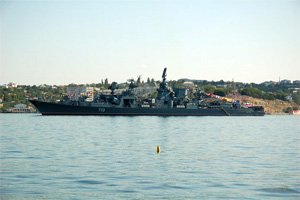29.07.10
Text: , Ilya Kramnik
Photo: The Kerch anti-submarine warfare ship. RusNavy.com
| Tell a friend | Print version |
|---|
Home / Russia / Structure of the Navy / Black Sea Fleet / Sevastopol and the Black Sea Fleet: the story goes on
Sevastopol and the Black Sea Fleet: the story goes on
Every last Sunday in July Russia celebrates Navy Day. This year's celebrations were held on July 25. Sevastopol, the main base of Russia's Black Sea Fleet, hosted a naval parade. In retrospect, this event requires serious appraisal.

Sevastopol's old town mostly owes its layout to Admiral Mikhail Lazarev (1788-1851), a legendary explorer and naval commander who circumnavigated the world three times in the early 19th century. Many famous Russians served with the Black Sea Fleet, which has always been primarily stationed in Sevastopol. Admiral Fyodor Ushakov (1744-1817) won international fame while commanding fleet elements in the late 18th century. Admirals Vladimir Kornilov (1806-1854) and Pavel Nakhimov (1802-1855) were both killed in the defense of Sevastopol during the 1853-1856 Crimean War. Admiral Sergei Gorshkov (1910-1988), the father of the ocean-going Soviet Navy, also fought here during World War II.
Considering the role of the fleet and its commanders in the city's history, it is hardly surprising that Navy Day is perhaps the most popular local holiday, rivaled only by the liberation of Sevastopol on May 9, 1944 and Victory in Europe Day, also celebrated on May 9.
Annual Navy Day parades highlight the state of the Russian Navy, although this assessment appears too good to be objective. After the break-up of the Soviet Union in 1991, the Navy was also on the decline. Moreover, the Black Sea Fleet was divided between Russia and Ukraine, losing numerous warships and support ships, and much of the coastal infrastructure.
It was impossible to renew fleet elements. Ukraine had hindered this process for a long time and Russia did not build new warships. As a result, the Black Sea Fleet became Russia's most obsolete because the majority of its capital warships were launched in the 1970s. Although the Moskva cruiser, the Kerch anti-submarine warfare ship, as well as the Ladny (Well-Built), Pytlivy (Inquisitive) and Smetlivy (Keen) escort ships, have a long and glorious service record, they should now be replaced. The Moskva is the only ship on this list that can continue to serve beyond 2020 after a major overhaul.
Against this backdrop, Fleet Admiral Vladimir Vysotsky, Commander of the Russian Navy, said during the Navy Day parade that the fleet would receive 15 new warships in the next decade. He promised that the first two warships would arrive before the year was out.
The Baltic Fleet is to contribute its Project 1154 frigates Yaroslav Mudry (Yaroslav the Wise) and Neustrashimy (Intrepid) frigates to the Black Sea Fleet. The latter ship was commissioned in 1994. The Baltic Fleet will receive the more advanced Project 11356 and 22350 frigates, as well as the upgraded Project 20380 Steregushchy-class frigates. The Black Sea Fleet is to receive additional new warships soon. The keels of three frigates and three submarines are to be laid in the near future.
Such haste is explained by the fact that most fleet warships have almost expended their service life and by the numerous objectives facing the Russian Navy in the Black Sea Fleet's zone of responsibility. These include guaranteeing the security of southern Russian regions on the Black Sea, military presence in the Mediterranean Sea, and protection of shipping and anti-piracy operations in the western sector of the Indian Ocean.
All these objectives require advanced multi-role warships. The Black Sea Fleet's main elements, except the Moskva cruiser, are well suited for anti-submarine warfare (ASW) missions, but have a rather modest strike potential and relatively weak air defense systems.
The Yaroslav Mudry and the Neustrashimy, which are equipped with up-to-date weapons control systems and missiles may considerably expand the fleet's potential by replacing two out of three escort ships serving with an ASW ship division.
It should be noted that the Yaroslav Mudry, a Neustrashimy-class warship, was completed at a later date and has a more impressive strike potential than the latter because she features more sophisticated equipment and Zvezda Kh-35U/Uran (AS-20 Kayak) anti-ship missiles. The Neustrashimy, due to be overhauled in the next few years, will acquire new equipment and Uran missiles, which are part of its standard arsenal. This notwithstanding, the warship already packs a more devastating punch than any other escort ship currently serving with the Black Sea Fleet.
Even this small addition will considerably expand the fleet potential. All 15 new warships, due to be delivered by late 2020, will make it possible to completely reorganize the fleet, to replace all first-line warships, to change the fleet's tables of organization and to create conditions for strengthening the fleet still further, all the more so as modern warships have a 30-year-plus service life.
The process may appear ponderous, but battle-worthy naval formations can take much longer to deploy than those of the other services.



